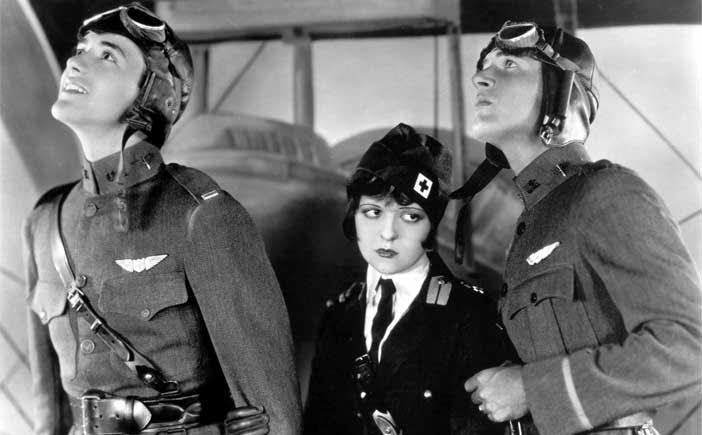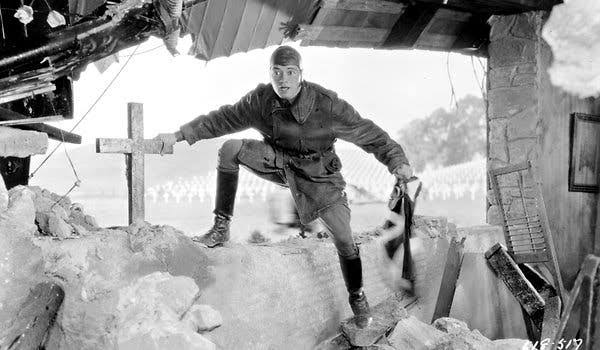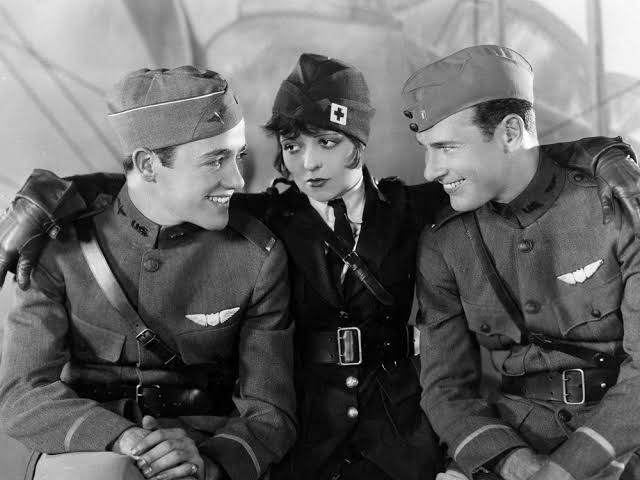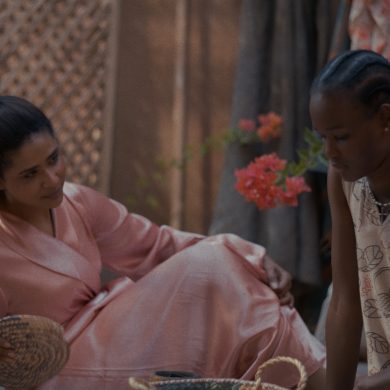William A. Wellman’s masterful war epic, Wings, holds the honour of kicking off the Academy Awards by winning the Best Outstanding Picture award. While the grander, undeniable masterpiece of cinema, Sunrise: A Song of Two Humans won an equal award – Unique and Artistic Picture, the only time the award was delivered -, it’s been this World War One battler that has endured in history as the first Best Picture Winner.
For many modern viewers, the only image or knowledge of Wings is the iconic, ‘over the tables’ push-in shot on lead actor Charles “Buddy” Rogers, Jack, lifting a glass of champagne and grinning. It’s a stunning shot that belies the current belief that early films were technically restrained. It’s clear that from this shot alone, Wings is anything but technically restrained, a mentality that was applied with vigour and vitality to the rest of the film.
This genre-combining, era-defining war film focuses on two young American men, Jack (Rogers) and David (Richard Arlen), both eager to participate in the fight for freedom in World War One, enlisting in the army to become pilots. In the time of civility before they head off to basic training, both men engage in relationships with two women, Clara Bow’s Mary and Jobyna Ralston’s Sylvia.
Mary is smitten with Jack, and shows her affection by helping him paint his car, going so far as to put a symbol of hope on it: “The Shooting Star”. Jack only sees her as a friend, and sees Sylvia as his true love, and works about wooing her. Alas, unbeknownst to Jack, Sylvia’s heart belongs to David, and she has written a love letter declaring her affection for him, of which she intends to give it to him prior to him leaving.
But, circumstance has it that Jack meets Sylvia moments before she is able to pass on the letter, and his eagerness for love denies her the opportunity to say that the letter was for David. Seeing the hope in his eyes, and knowing that he will need a beacon of hope to hold onto as he heads off to war, she says nothing. David arrives moments later, and after Jack leaves, full of pride and gusto, Sylvia professes her love to David, informing him of what she had to do.
For both men, as they battle in the skies, fighting through the horrors of World War One, they each hold onto the notion that they will have Sylvia to return to. For David, he recognises the importance of that hope for Jack, and being a true friend, respects that hope by delivering silence about Sylvia, all the while maintaining written communication with her.
For Mary, her love and affection for Jack pushes her into a role of support, delivering her to the frontline in Europe to provide care for the soldiers. As the war rages on, and Jack’s deftness at dispatching foes via his trusty plane, emblazoned with the symbol of “The Shooting Star”, Mary’s adoration and hope for his safe journey home grows.
Performance wise, Clara Bow is a delight, providing an electric energy every time she’s on screen. It’s impossible not to smile when she appears, with the ballast she provides to this masculine-focused film showing a welcome feminine energy to war that is often disregarded for the easy-crux of the doting, waiting wife at home. Bow’s boots on the ground Mary plays a tangible role in assisting soldiers in war, supporting, caring, and lifting those up in need.
Elsewhere, Rogers and Arlen’s chemistry helps provide the brotherly bond that is necessary to allow Jack and David’s relationship to feel real. David’s respect of Jack’s emotions, and the awareness of the plight they both find themselves in, shows a powerful level of selflessness that helps typify the identity and fortitude of a soldier. The two know the depths of despair they find themselves in, and as such, they find comfort in the knowledge that there is a woman out there who has them in their hearts. It just happens to be the same woman.
While much of the basic plotting for Wings is focused around a love triangle, one that would provide the framework for many war-based epics going forward, the core narrative takes place on the battlefields of Europe, thrusting our two heroes into desperate situation after desperate situation. While William A. Wellman’s thrilling film is more of a lighter fare than the third Best Picture winner, All Quiet on the Western Front, (a film that presents the darkness of war in all its brutality), it still presents the reality of war with exceptional vibrancy.


Now, this isn’t the blood and guts of Spielberg’s Saving Private Ryan, given the limitations of the era, but Wellman still worked hard to ensure that the viewer was immersed as completely in the action as possible. The lengths that he went to do this have been echoed in modern times, with boot camps becoming the norm for directors to immerse their actors in the reality of combat. Elsewhere, the prominence of the one-man-stunt-team Tom Cruise, and his eagerness to thrust himself into months long training sessions to learn how to fly fighter jets, was preceded by Wellman’s decision to have Charles “Buddy” Rogers and Richard Arlen fly the planes they would be acting in.
For Arlen, a military aviator in World War One, this was no trouble, but for Rogers, this meant spending months learning how to fly the combat planes. Both actors knew that once filming would take place, they would be the sole occupants of their vessels, with the massive cameras bolted onto the fuselage of the plane, and each actor having to dictate when they would call action or cut. There were two accidents on set, with stunt pilot Dick Grace being injured, as well as a fatal crash involving a United States Army Air Corps pilot. This tragedy added to the real fear within Arlen and Rogers acting, after all, the actors had genuine threats to fear.
The footage is simply unparalleled, with few films in cinema history being able to deliver the visceral nature of the dogfights. With around 300 pilots being utilised, and Wellman’s know-how and understanding to shoot the flight sequences against clouds to provide a backdrop to give viewers an appreciation of the intensity of the combat, the thrilling energy of Wings was established. For the ground-based battles, hundreds of extras were employed, with extensive rehearsals taking place with actual infantrymen. Some thirteen cameramen were utilised, with handheld cameras being utilised in the Battle of Saint-Mihiel, allowing the same level of immersion on ground as provided in the air.
An early battle sequence that collates all of our main characters together at once – Jack and David in the air, Mary on the ground, driving an ambulance to help the troops – is devastating and genuinely intense. A giant bomber, a Gotha, cuts a path through the air, blacking out the sun with its enormity. It’s flanked by fighter planes, defending it from the attacks of Jack and David’s allied forces. Wellman frames this sequence perfectly, with Mary’s support being under direct threat as she arrives into the town of Mervale unaware of the impending doom.
All of this excitement and action would mean little if the film weren’t given the essential backbone of an engaging plot and exceptional acting that it needed to truly shine. There’s a reason this kind of narrative has been imitated time after time. Simply put: it works.
Wellman’s eye in the sky camera shots show the mammoth destruction and brute force that these bombers carried, with buildings crumbling under the impact of its tumbling munitions. Mary’s fear is tangible, for we can feel the impact of what she’s experiencing. This genuine destruction creates a reality that is hard to imitate in the modern world of computer conjured effects. It’s clear that Christopher Nolan utilised the iconography of Wings as a template for the tangible destruction within Dunkirk, helping set that film apart from the digital trickery, yet still immersive, theatrics of Sam Mendes’ 1917.
The climactic battle is brutal and lean. Battles rage in the sky, while on the ground, all out violence and chaos has erupted, with soldiers resorting to punch ups and stabbings as their bullets have run out. Wellman delivers a chaotic, horrifying glimpse of the terror of war, albeit with a gung-ho, earnestly pro-war stance. Even with the sight of a man getting crushed by a tank, it’s hard to not watch Wings with Francois Truffaut’s statement about every film about war ending up being pro-war:
I find that violence is very ambiguous in movies. For example, some films claim to be antiwar, but I don’t think I’ve really seen an antiwar film. Every film about war ends up being pro-war.
In addition to that statement is the journalists approach to Truffaut’s statement:
War isn’t hell; it’s just the men who run them are frequently hellish. And every war film, just like every war, has its heroes, and that, too, seems to cut across any antiwar sentiment.
The battles in Wings are thrilling, full of genuine moments of excitement that exist to have you leaping out of your seat in joy, cheering on our heroes. This is not a propaganda-focused film, nor is it earnestly pro-military, instead, it’s pro-hero and pro-soldier. These aren’t men fighting for their country or their flag, instead, they’re men fighting for each other, and the hope of returning to loved ones. They fight for the promise of the safety that family brings.
This was an era where those at home were not afforded the immediacy of footage that came with the Vietnam war, and as such, the thrilling terror of war existed through films like Wings. These enemies, rarely humanised here, are the immediate threat to that promise, and as such, their demise makes for an exceptionally pro-war film. This ‘Great’ war extinguished many souls, but Wellman’s film takes the heroics of the fallen and idolises them.
As we follows our determined heroes into their final battle, we witness David being shot down over enemy lines. The immediate reaction is that he has died, but through immense heroics and ingenuity, he manages to find himself near the enemies airfield, and takes off with one of their planes, intending to return to the safety of his allies.
Yet, with Jack earnestly conquering enemy planes, keeping the infantry on the ground safe, David finds himself at the mercy of his friend, who is unaware of the circumstance he is in. The contrast between the two men is stark and clear here, with an earlier moment of David engaging in a fair fight between an enemy, holding back from shooting and pulling away from the fight when he sees a German pilots gun has jammed.


Here, Jack can’t help but take another notch down. Where David sees an ally, and doesn’t shoot, hoping that that act of submission would keep him safe, Jack’s adrenaline and vigour for the fight overcomes that awareness, and as such, shoots David down. It’s the harshest of blows for both heroes, one that leads to another notorious moment in relation to Wings history.
As David lays dying, Jack rushes to his aide, recognising the devastating impact of his militaristic defense. Here, the two share cinemas first same gender kiss. This is not an erotic kiss, but is a sign of the times where friends and family would show affection and companionship by kissing each other on the mouth. This is an echo of a moment earlier in the film where David bids his tearful mother goodbye by kissing her on the mouth.
It’s easy to look at Wings through modern eyes and lay a gay subtext on the film, eagerly hoping that there is a progressive slant to this forward-thinking film, yet, look all you might, it simply isn’t there. However, look elsewhere and you’ll find risqué elements that were soon to be squashed by the imminent arrival of the Hays Code. A blink and you’ll miss it glimpse of a topless Clara Bow comes after a moment of alcohol driven debauchery – of which Rogers himself was drunk throughout as it was his first moment of consuming alcohol – is paired with an earlier glimpse of naked men lining up for the medical examinations.
There’s an odd level of modernity to Wings. It feels both of the moment – the 1920s – and eerily current – as of writing, the 2020s, a century later. The action is unrestrained, the energy is vibrant and alive, and while the film is a silent production, Wellman’s choice of providing applied sound effects for the battles immerses you completely into the world of the film. It’s an imminently watchable, thoroughly entertaining film that feels timeless.
And yet, what makes Wings carry deft relevance to today is the undercurrent of devout patriotism. Initially, another soldier, Herman Schwimpf (El Brendel), a German-American, has his patriotism for America questioned. How could someone with German heritage want to fight against his mother-country under the shadow of the star-spangled banner? Yet, rolling up his sleeves to defend his honour, he shows a tattoo of America, showing his unwavering allegiance to America.
Brendel is fine as Schwimpf, but it’s hard to shake the feeling that Wellman’s direction intends to have the audience laugh at his actions. He continually engages in pratfalls and hijinks, tumbling over and being on the receiving end of the comedic energy of the film. While this kind of gentle-ribbing is delivered in good spirits, with the intention of ingratiating a ‘foreigner’ into the American spirit, one can’t help but look at the modern landscape of the way soldiers born in countries other than America are treated in the American military, often given a rougher treatment because of their country of origin. This kind of light-hearted treatment outwardly seems jovial, but from a modern perspective comes across as extensive bullying. This isn’t a large enough element to colour the entirety of Wings negatively, but it is a notable aspect that is worthwhile mentioning.
Jack returns home, a broken hero, a fractured soul, devastated when he sees David’s mother, equally broken. She provides a gentle comfort to Jack, forgiving him for his role in her sons death, noting that it was not him that killed David, but the war itself. It’s a tender line that speaks volumes through the silence of the film. These soldiers are merely enacting the will of those who bark orders, a theme that rings just as loud in All Quiet on the Western Front. The will of the soldier is a notion that comes under great scrutiny in later films, such as Kubrick’s finest hour, Paths of Glory, and Beresford’s acerbic Breaker Morant, but here in Wings, that will is shown to be unwavering in the face of the enemy. It is one that tows the line, and exists to conquer the foe and triumph over evil.
Jack’s journey is the one at the core of Wings, and it’s his growth as a man that brings the film to its conclusion. He has discovered the correspondence that Sylvia had maintained with David, and realises the consideration that his fallen friend had for his mind during this torturous war. Recognising that Sylvia’s heart was not his to have, he recalls the enduring affection that Mary had for him, and as such, finds comfort in her arms. It’s a testament to Clara Bow and Charles “Buddy” Roger’s performance that this moment carries the weight of truth, distilling the soon-to-be-rote Hollywood-esque ending that ties things up neatly.
As a grand cinematic achievement, it’s astonishing that Wings is not celebrated more. Sure, it has its place in cinematic history as the first Best Picture winner, but arguably, that kind of accolade should elevate higher than being an answer to a trivia question. I fear that the mere fact that it’s a silent film is enough to turn modern viewers away from watching this grand film, and if that’s the case, then I’m disappointed. Cinema as a whole needs to be embraced, and part of that embrace is honouring and recognising the foundations of cinema.
Simply put: Without Wings, we wouldn’t have Dunkirk, Saving Private Ryan, or Tom Cruise, and many more aspects of war-focused cinema.
That notion alone could get viewers to seek out this film, but ideally, the mere fact that this is a genuinely great, enjoyable film should be reason enough. William A. Wellman’s magnificent direction and risky decision making may seem reckless, but time has shown that it has paid off.


Director: William A. Wellman
Cast: Charles “Buddy” Rogers, Clara Bow, Richard Arlen
Writer: Hope Loring, Louis D. Lighton, Titles by: Julian Johnson, Story by: John Monk Saunders




